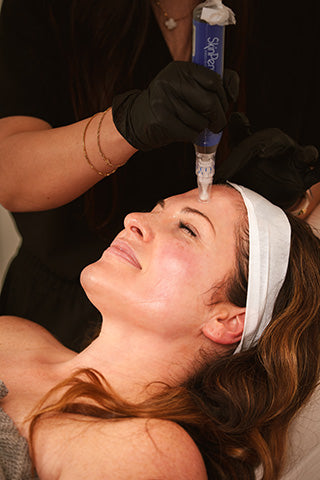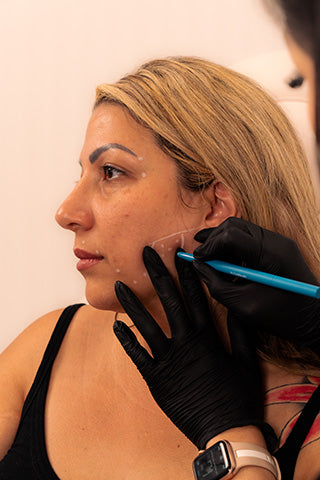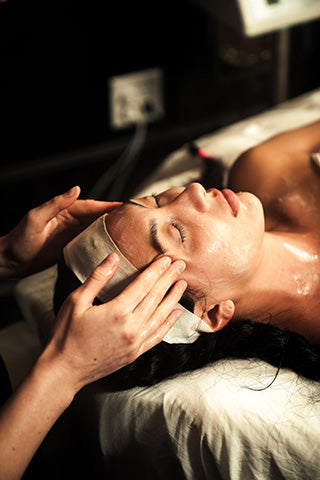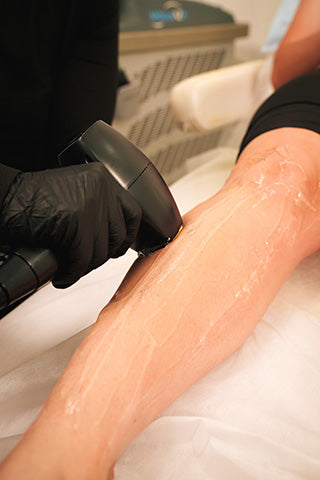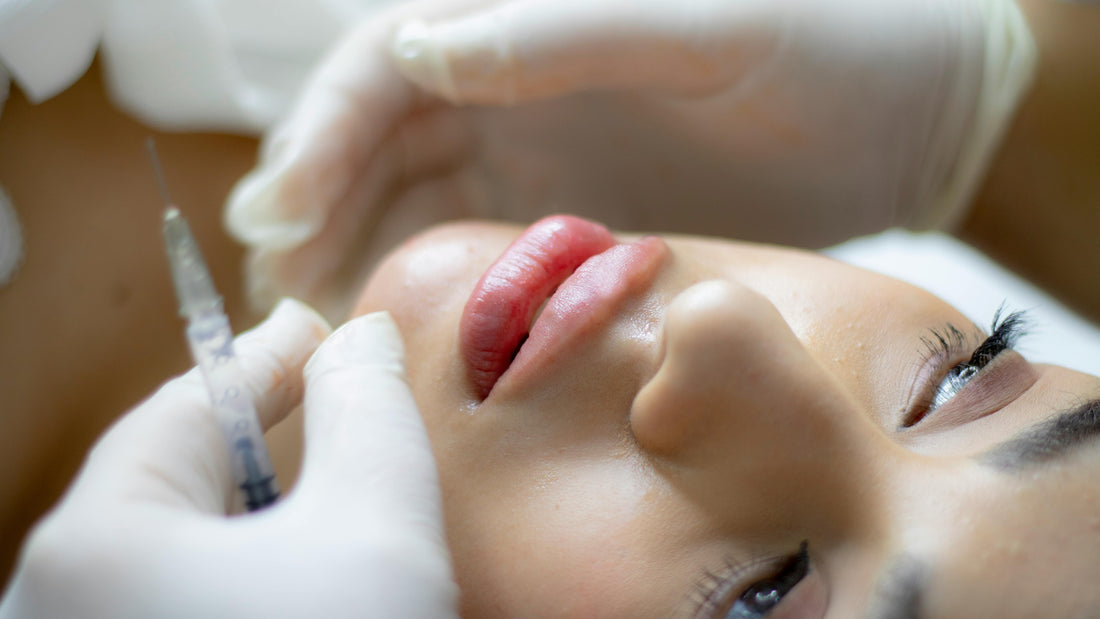Understanding the Basics of Lip Enhancement
When considering lip enhancement, two primary options are lip fillers and lip lifts. Each offers distinct benefits and limitations, making them suitable for different individuals.
Lip Fillers: Temporary Enhancement Through Injection
Lip fillers are injectable substances, typically hyaluronic acid-based, that add volume to the lips. Brands like Juvederm and Restylane temporarily plump the lips, creating a fuller appearance with minimal downtime. The procedure involves several small injections into the lip area, with results typically lasting 6–18 months before the body naturally metabolizes the filler material.
There are various injection techniques used to achieve different lip shapes and effects. Understanding these techniques can help you communicate your desired outcome with your provider. Learn more about the popular injection techniques of lip augmentation.
Lip Lifts: Surgical Enhancement for Permanent Results
A lip lift is a surgical procedure that shortens the space between the nose and the top of the lip (philtrum), creating a permanent enhancement to lip appearance. By removing a small strip of skin below the nose and lifting the lip upward, this procedure reveals more of the pink part of the upper lip and creates a more youthful, defined appearance. Unlike fillers, a lip lift provides permanent results through a single surgical intervention.
Procedure Comparison: Lip Fillers vs. Lip Lift
|
Feature |
Lip Fillers |
Lip Lift |
|
Procedure Type |
Minimally invasive injection |
Surgical procedure |
|
Duration of Results |
Temporary (6–18 months) |
Permanent |
|
Time Per Session |
Approximately 30 minutes |
1–2 hours |
|
Recovery Period |
Minimal downtime (1–3 days) |
1–2 weeks downtime |
|
Discomfort Level |
Mild discomfort, topical anesthesia |
Moderate discomfort, local anesthesia/IV sedation |
|
Reversibility |
Can dissolve with hyaluronidase |
Irreversible (would require revision surgery) |
Alternative Lip Enhancement Methods
Beyond traditional fillers and lifts, several other methods are available for lip enhancement:
Fat Grafting
Procedure: Fat is harvested from another area of your body (typically abdomen or thighs) through liposuction, processed, and then injected into the lips.
Results: Creates naturally full lips with a soft feel since it uses your own tissue.
Longevity: Semi-permanent, with results lasting years as some fat cells establish permanent blood supply.
Best For: Patients seeking natural enhancement without foreign substances and who have adequate donor fat.
Considerations: Requires a more complex procedure including liposuction; results can be somewhat unpredictable as some fat may be reabsorbed.
Lip Implants
Procedure: Soft, flexible silicone implants are surgically inserted into the lips through small incisions.
Results: Provides significant, consistent volume enhancement.
Longevity: Permanent unless removed.
Best For: Patients wanting dramatic, lasting results without maintenance treatments.
Considerations: More invasive with higher risk of complications including implant displacement, infection, and potential need for removal if unsatisfied.
Who Is It Best For? Ideal Candidates
Lip Fillers Are Ideal For:
-
First-time lip enhancement patients wanting to "test" a new look.
-
Younger individuals seeking subtle volume enhancement.
-
People want flexibility to adjust their look over time.
-
Those preferring minimal downtime and gradual enhancement.
-
Patients uncomfortable with permanent surgical changes.
A Lip Lift Is Ideal For:
-
People with a naturally long upper lip area (philtrum).
-
Older individuals experiencing age-related lip thinning.
-
Those seeking enhanced visibility of the upper teeth when smiling.
-
Patients wanting a more defined Cupid's bow.
-
People are tired of repeated filler injections and associated costs.
Provider Qualifications: Choosing the Right Expert
When selecting a provider for lip enhancement, certain credentials and experience are crucial for optimal results and safety.
For Lip Fillers:
-
Board Certification: Choose providers certified in dermatology, plastic surgery, facial plastic surgery, or with specialized training in cosmetic injectables.
-
Experience Level: Look for providers who perform lip injections regularly and can show a portfolio of their work.
-
Technical Knowledge: The provider should understand facial anatomy, particularly the arterial network around the lips, to avoid vascular complications.
-
Aesthetic Vision: Find someone whose aesthetic results match your desired outcome by reviewing their before and after photos.
For Lip Lifts:
-
Board Certification: Select only board-certified plastic surgeons or facial plastic surgeons with specific training in lip lift procedures.
-
Surgical Experience: Ensure they regularly perform lip lifts specifically (not just general plastic surgery).
-
Scar Management Skills: Ask about their techniques for minimizing visible scarring, especially at the base of the nose.
-
Revision Experience: Inquire about their approach to revisions if needed, as this indicates confidence and expertise.
Detailed Aftercare Instructions
For Lip Fillers:
Immediate Care (First 48 Hours):
-
Apply ice intermittently for 10–15 minutes to reduce swelling.
-
Avoid touching or massaging the lips unless specifically instructed.
-
Stay hydrated but avoid alcohol consumption.
-
Sleep with your head elevated to minimize swelling.
-
Take acetaminophen for discomfort (avoid aspirin/ibuprofen, which can increase bruising).
Extended Care (First Week):
-
Avoid strenuous exercise for 24–48 hours.
-
Skip saunas, hot yoga, steam rooms, and excessive sun exposure.
-
Wait 24 hours before applying makeup to the treated area.
-
Use gentle skincare products, avoiding harsh exfoliants.
-
Stay hydrated to maintain optimal filler appearance.
Long-term Maintenance: Schedule follow-up appointments if recommended, consider maintenance treatments when volume begins to diminish, and use SPF on lips to protect them from sun damage.
For Lip Lifts:
Immediate Care (First Week):
-
Keep the incision site clean and dry.
-
Apply prescribed antibiotic ointment as directed.
-
Take medications as prescribed for pain management.
-
Use cold compresses carefully to reduce swelling (avoid direct pressure).
-
Follow a soft diet to minimize movement and tension on the suture line.
Extended Care (2–4 Weeks):
-
Avoid strenuous activities for at least two weeks.
-
Attend all follow-up appointments for suture removal and monitoring.
-
Protect the incision from direct sun exposure.
-
Begin gentle scar massage as directed by your surgeon once healing permits.
-
Use silicone-based scar treatments if recommended.
Long-term Care: Continue scar management for 6–12 months and use sunscreen on the scar area to prevent hyperpigmentation.
How Individual Factors Affect Your Choice
Understanding how your unique characteristics influence treatment selection is crucial for optimal results.
Age Considerations
Younger Patients (20s–30s): Generally better candidates for fillers, typically seeking volume enhancement rather than structural changes, often prefer non-permanent options to allow for changing preferences.
Mature Patients (40s+): May benefit more from lip lifts due to age-related lengthening of the philtrum, often experience thinning of the vermillion border that lifts can address, may have undergone years of fillers and desire a permanent solution.
Skin Type and Ethnicity Factors
Thin Skin: May show filler more obviously with potential for visibility or an unnatural appearance, requires very careful, conservative filler placement, may benefit from firmer fillers like Restylane for better structure.
Thick Skin: Can accommodate larger volumes of filler without obvious visibility, may require more significant intervention to show noticeable results, often responds well to structural changes from a lip lift.
Ethnic Considerations: Different ethnic backgrounds have varying lip structures and aesthetic ideals. Cultural preferences for lip appearance should be discussed with your provider. Anatomical differences may influence technique selection and outcome.
Facial Anatomy Considerations
Long Philtrum: Primary indication for lip lift surgery, may not be adequately addressed with fillers alone, surgical correction provides more harmonious facial proportions.
Thin Vermillion (Pink Portion): May benefit from both volume (fillers) and structural change (lift), requires careful assessment to determine the dominant concern.
Asymmetry: Often better addressed with the precision of fillers initially, surgical approaches may be considered for significant structural asymmetry.
Results: What Can You Realistically Achieve?
Lip Fillers Can Provide:
-
Increased lip volume and plumpness.
-
Smoothing of vertical lip lines.
-
Minor shape correction and symmetry improvement.
-
Subtle enhancement of lip borders.
-
Natural-looking results that can be adjusted in subsequent sessions.
For different lip shapes achievable with fillers, explore types of lip filler shapes.
Lip Lifts Can Deliver:
-
Permanent shortening of the upper lip area.
-
Significantly increased visibility of the upper lip.
-
Enhanced Cupid's bow definition.
-
More tooth show when smiling.
-
Correction of age-related lip changes that fillers cannot address.
Costs Involved: Lip Fillers vs. Lip Lift
|
Cost Factor |
Lip Fillers |
Lip Lift |
|
Initial Investment |
$500–$1,000 per session |
$2,000–$5,000 (one-time) |
|
Annual Maintenance |
$1,000–$2,000 (for 1–2 sessions) |
$0 |
|
5-Year Total Cost |
$5,000–$10,000 |
$2,000–$5,000 |
|
10-Year Total Cost |
$10,000–$20,000 |
$2,000–$5,000 |
While lip fillers have a lower entry cost, they become significantly more expensive over time compared to a one-time lip lift investment.
Potential Risks and Side Effects: Which Is Safer?
Lip Fillers Risks:
-
Temporary swelling, bruising, and redness.
-
Potential lumpiness or asymmetry (usually correctable).
-
Rare allergic reactions or vascular complications.
-
Risk of migration or unnatural appearance if overdone.
-
Possibility of granulomas or nodules.
Lip Lift Risks:
-
Visible scarring at the base of the nose, although skilled surgeons work to minimize its appearance.
-
Post-surgical swelling and bruising.
-
Potential asymmetry requiring revision.
-
Risk of infection or poor wound healing.
-
Possible tissue damage or nerve injury (rare).
Generally, fillers carry fewer significant risks but require repeated exposure to these risks over time, while a lip lift involves one-time surgical risks but no ongoing risk exposure.
Practical Decision-Making: Questions to Ask Yourself
Before choosing between lip fillers and a lip lift, consider these critical questions:
-
Timeline: Do I want immediate, temporary results, or am I willing to wait for permanent enhancement?
-
Budget: Am I prepared for ongoing costs of fillers or a larger one-time investment?
-
Commitment: Am I certain about the look I want, or do I prefer flexibility to change my mind?
-
Downtime: Can I accommodate recovery time for surgery, or do I need to minimize downtime?
-
Aging Concerns: Am I primarily addressing volume loss or structural changes due to aging?
-
Risk Tolerance: Which potential complications am I more comfortable accepting?
Comparing Lip Filler Brands: Juvederm vs. Restylane
When considering lip fillers, it's important to understand the differences between major brands:
Juvederm
Formulation: Juvederm uses Vycross technology, combining low and high-molecular-weight hyaluronic acid to create a smooth, gel-like consistency that integrates easily into the skin. This formulation allows for natural movement and feel.
Product Lines: Juvederm offers specific products for lip enhancement, including Juvederm Volbella XC, designed for subtle lip enhancement and smoothing of vertical lip lines, and Juvederm Ultra XC, created for more significant volume enhancement.
Longevity: Typically lasts 12–18 months, making it one of the longer-lasting filler options available.
Unique Benefits: Tends to provide smoother results with less swelling due to its formulation technology.
Restylane
Formulation: Restylane has a firmer consistency compared to Juvederm, using XpresHAn technology that allows for more defined structural enhancements while maintaining natural facial expressions.
Product Lines: Restylane offers several lip-specific products like Restylane-L for general lip enhancement, Restylane Kysse for natural-looking lip enhancement, and Restylane Silk formulated for precise lip definition and smoothing fine lines.
Longevity: Generally lasts 6–12 months, slightly shorter than Juvederm.
Unique Benefits: Provides more structure and definition, making it excellent for creating lip border definition.
For a deeper comparison of different types of lip fillers and injectables, consider this match-up of lip fillers.
Frequently Asked Questions
1. Is it better to get a lip flip or filler?
A lip flip (using Botox to roll the lip outward) and lip fillers serve different purposes. Lip flips are ideal for those wanting subtle enhancement without added volume, while fillers add actual volume. Patients should discuss options with their providers to decide which suits their goals. Lip flips typically last 2–3 months and cost less per treatment than fillers.
2. What are the cons of a lip lift?
The main disadvantages of a lip lift include visible scarring at the base of the nose, although skilled surgeons work to minimize its appearance. Recovery can take 1–2 weeks, with swelling and bruising. Results are permanent unless revised surgically and may require revision if results are uneven. It is more expensive initially compared to fillers. Additionally, if not performed correctly, a lip lift can create an unnatural appearance or affect your smile.
3. What lip fillers do celebrities use?
While celebrities haven't officially disclosed their specific lip filler brands, plastic surgeons often report that hyaluronic acid fillers like Juvederm Volbella, Juvederm Ultra, and Restylane Kysse are popular among those seeking a full-lip look. Celebrities may combine various filler techniques with possible surgical interventions for their signature looks.
4. How long does a lip lift last?
A lip lift is considered a permanent procedure. The results will last indefinitely, though natural aging will continue to affect your facial appearance over time. Unlike temporary fillers that dissolve, the structural changes from a lip lift remain unless surgically revised. Most patients enjoy their results for many years without requiring additional procedures.
Making the choice between lip fillers and a lip lift is ultimately personal, based on your unique facial structure, aesthetic goals, and lifestyle considerations. As a surgeon, my best advice is to consult with qualified professionals who can assess your specific needs and recommend a customized enhancement plan. Both options can provide beautiful, confidence-boosting results when performed by skilled practitioners.
